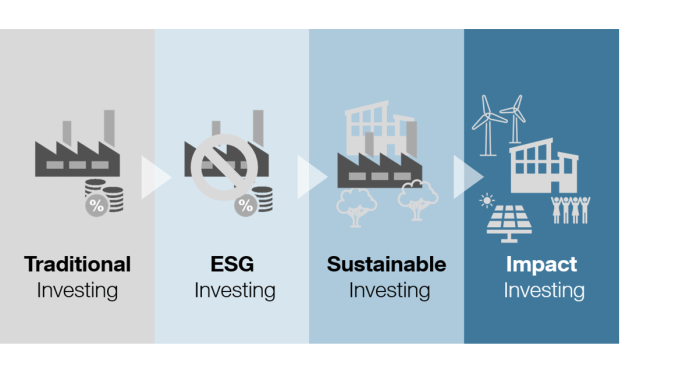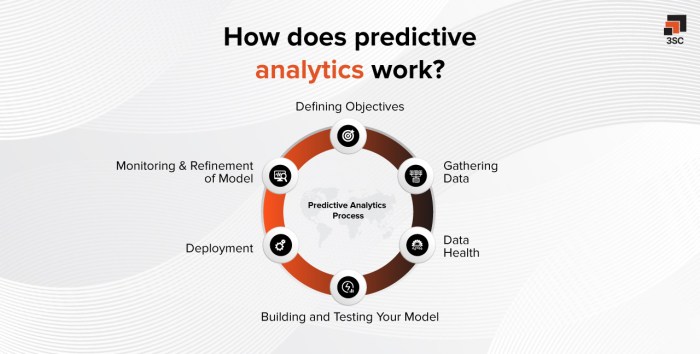How Big Data is Redefining the Future of Financial Decision-Making: The financial world is undergoing a seismic shift, driven by the unprecedented availability and analysis of massive datasets. No longer reliant solely on historical data and gut instinct, financial institutions are leveraging the power of big data to make more informed, precise, and ultimately, profitable decisions. This transformation is impacting every facet of finance, from risk management and fraud detection to personalized customer services and regulatory compliance.
This exploration delves into the multifaceted ways big data is reshaping the financial landscape. We will examine advanced analytical techniques, the challenges of implementation, and the ethical considerations involved. Ultimately, we aim to provide a comprehensive understanding of how this technological revolution is paving the way for a more efficient, transparent, and customer-centric financial future.
The Expanding Role of Big Data in Finance: How Big Data Is Redefining The Future Of Financial Decision-Making
The financial industry has undergone a dramatic transformation fueled by the exponential growth of data. Traditional methods, reliant on limited datasets and manual analysis, are being rapidly replaced by sophisticated big data analytics. This shift is not merely incremental; it represents a fundamental change in how financial institutions make decisions, manage risk, and identify opportunities.
Evolution of Data Usage in Financial Decision-Making
Historically, financial decision-making relied heavily on human intuition, experience, and relatively small, structured datasets. Analysts would pore over spreadsheets and reports, applying established models to make predictions and assess risk. This approach, while valuable, was limited by its inherent biases and the restricted scope of available information. The advent of powerful computing capabilities and the proliferation of digital data sources, including transactional records, market data, social media sentiment, and alternative data, have fundamentally altered this landscape. Big data, encompassing vast volumes of structured and unstructured data, now provides a far richer and more comprehensive view of the financial ecosystem. This allows for more sophisticated analytical techniques, improved predictive modeling, and ultimately, better-informed decisions.
Impact of Data Volume, Velocity, and Variety on Financial Modeling and Forecasting
The three Vs of big data – volume, velocity, and variety – significantly impact financial modeling and forecasting. The sheer *volume* of data allows for the identification of subtle patterns and correlations that would be impossible to detect with smaller datasets. The increased *velocity* of data, reflecting the near real-time availability of information, enables quicker responses to market changes and more agile decision-making. Finally, the *variety* of data sources – encompassing both traditional structured data and newer unstructured sources like social media and news articles – provides a more holistic and nuanced understanding of market sentiment, risk factors, and emerging trends. These factors combine to create significantly more accurate and reliable financial models and forecasts.
Big Data Applications in Finance
Big data has revolutionized several key areas of finance. The following table illustrates the differences between traditional and big data approaches in specific applications:
| Application | Traditional Methods | Big Data Approaches | Improved Outcomes |
|---|---|---|---|
| Risk Assessment | Relied on historical data and established models; limited ability to capture emerging risks. | Utilizes machine learning algorithms on diverse data sources (market data, credit scores, social media sentiment) to identify and assess a wider range of risks in real-time. | More accurate risk scoring, improved risk mitigation strategies, reduced losses. |
| Fraud Detection | Rule-based systems with limited ability to detect sophisticated fraud schemes. | Employs anomaly detection techniques and machine learning on transactional data to identify unusual patterns indicative of fraudulent activity. | Higher detection rates, faster response times, reduced financial losses from fraud. |
| Investment Strategies | Based on fundamental analysis and limited market data; slower reaction to market shifts. | Uses algorithmic trading and predictive modeling on vast datasets (market data, news sentiment, social media trends) to identify profitable investment opportunities and optimize portfolio performance. | Improved portfolio returns, optimized risk-adjusted returns, faster execution of trades. |
| Customer Relationship Management (CRM) | Segmented customers based on limited demographic data; less personalized service. | Leverages customer data from multiple sources (transactions, website activity, social media) to create detailed customer profiles and personalize interactions. | Improved customer retention, increased customer satisfaction, targeted marketing campaigns. |
Advanced Analytics and Predictive Modeling
The integration of big data with advanced analytical techniques has revolutionized financial decision-making. These techniques allow financial institutions to move beyond simple descriptive statistics and delve into predictive modeling, enabling them to anticipate market shifts, assess risk more accurately, and optimize investment strategies. This section will explore the key analytical methods employed and their implications for the financial sector.
The power of big data lies in its ability to fuel sophisticated predictive models. By leveraging vast datasets encompassing market behavior, economic indicators, and individual customer profiles, financial institutions can develop models capable of forecasting future outcomes with significantly improved accuracy compared to traditional methods. This enhanced predictive capability is achieved through the application of various advanced analytical techniques.
Machine Learning and Deep Learning in Financial Prediction
Machine learning (ML) and deep learning (DL), subsets of artificial intelligence, are increasingly prevalent in financial applications. ML algorithms, such as support vector machines (SVMs), random forests, and gradient boosting machines, identify patterns and relationships within large datasets to make predictions. These algorithms can be used to predict credit risk, forecast stock prices, and detect fraudulent transactions. Deep learning, a more complex form of ML utilizing artificial neural networks with multiple layers, excels at handling unstructured data like text and images, making it suitable for tasks like sentiment analysis of news articles to gauge market sentiment or analyzing images of financial documents for fraud detection. For example, a bank might use a deep learning model trained on historical loan applications and borrower data to predict the likelihood of loan defaults, allowing for more informed lending decisions and reduced risk.
Advantages and Limitations of Advanced Analytics in Finance
The advantages of employing these techniques are substantial. They offer increased accuracy in predictions, leading to better risk management, improved investment strategies, and enhanced fraud detection capabilities. The automation of tasks also improves efficiency and reduces operational costs. However, limitations exist. The complexity of these models can make them difficult to interpret (“black box” problem), hindering understanding of the underlying reasons for predictions. Data quality is crucial; inaccurate or incomplete data will lead to flawed models and unreliable predictions. Furthermore, the computational resources required to train and run these complex models can be significant. Finally, overfitting—where a model performs well on training data but poorly on new data—is a persistent challenge requiring careful model validation and regularization techniques.
Big Data’s Role in Enhancing Predictive Model Accuracy
Big data’s sheer volume, velocity, and variety are essential for developing more accurate and sophisticated predictive models. The greater the volume of data, the more robust and reliable the models become. The velocity, or speed at which data is generated and processed, allows for real-time analysis and quicker responses to market changes. The variety of data sources—including transactional data, social media sentiment, news articles, and economic indicators—provides a richer and more comprehensive understanding of the factors influencing financial outcomes. For instance, incorporating alternative data sources, such as satellite imagery to assess retail foot traffic or social media sentiment to gauge consumer confidence, can significantly enhance the accuracy of predictive models for economic forecasting and investment decisions. A hedge fund, for example, might use a model incorporating high-frequency trading data, news sentiment, and macroeconomic indicators to predict short-term price movements and execute trades accordingly.
Improving Risk Management and Fraud Detection

Big data analytics is revolutionizing risk management and fraud detection in the financial sector, offering unprecedented capabilities to identify and mitigate threats more effectively than traditional methods. The sheer volume, velocity, and variety of data available allows for a more nuanced understanding of risk profiles and fraudulent activities, leading to proactive strategies and improved outcomes.
Big data analysis significantly enhances the detection and mitigation of various financial risks. By processing vast datasets, financial institutions can gain insights previously unavailable, leading to more accurate risk assessments and better-informed decision-making.
Credit Risk Assessment
Credit scoring models, traditionally reliant on limited data points, are significantly improved through big data. The incorporation of alternative data sources, such as social media activity, online purchasing behavior, and mobile phone usage patterns, provides a more comprehensive picture of a borrower’s creditworthiness. This allows for a more accurate assessment of risk, reducing defaults and improving lending profitability. For example, a lender might identify a borrower with a seemingly good credit history who exhibits signs of financial distress based on their online spending habits, prompting a more cautious lending decision. This level of granular detail is simply not possible with traditional credit scoring methods.
Market Risk Management
Big data facilitates the identification of subtle market trends and anomalies, allowing for more accurate predictions of market volatility and risk. Real-time analysis of vast amounts of market data, including news sentiment, social media trends, and trading patterns, enables institutions to anticipate market shifts and adjust their portfolios accordingly. This reduces exposure to unexpected losses and improves overall portfolio performance. For instance, analyzing news sentiment around a specific company might reveal negative trends before they are reflected in traditional market indicators, enabling proactive portfolio adjustments.
Operational Risk Mitigation
Big data helps identify operational weaknesses and potential points of failure within financial institutions. By analyzing internal data such as transaction logs, system performance metrics, and employee activity, institutions can pinpoint vulnerabilities and implement preventative measures. This minimizes the risk of operational disruptions, fraud, and regulatory non-compliance. An example would be detecting unusual patterns in employee access logs that might indicate insider threats or unauthorized access attempts.
Enhanced Fraud Detection
Big data significantly improves the accuracy and efficiency of fraud detection systems. Traditional methods often rely on rule-based systems that struggle to adapt to evolving fraud techniques. Big data, combined with machine learning algorithms, allows for the identification of complex patterns and anomalies that indicate fraudulent activity. This leads to quicker detection, reduced losses, and improved customer protection. For example, machine learning algorithms can identify subtle patterns in transaction data that might indicate credit card fraud, even if the transactions individually appear legitimate. These patterns might be too complex for human analysts or rule-based systems to detect.
Hypothetical Scenario: Preventing a Major Financial Fraud
Imagine a large multinational corporation using big data analytics to prevent a sophisticated payroll fraud scheme.
- Unusual Activity Detection: The company’s big data system flags unusual activity – a significant increase in payroll payments to a small number of newly added employees, all with similar addresses and bank accounts.
- Data Correlation: The system correlates this data with other internal and external sources, such as IP addresses, geolocation data, and social media profiles, revealing that the “employees” are fictitious and likely connected to a single criminal operation.
- Predictive Modeling: Using predictive modeling, the system forecasts the potential financial loss if the fraud goes undetected, estimating it to be in the millions of dollars.
- Real-time Alert: The system generates a real-time alert to the company’s fraud investigation team, providing detailed evidence of the fraudulent activity.
- Fraud Prevention: The investigation team, armed with the data-driven insights, quickly stops the fraudulent payments, preventing a significant financial loss and protecting the company’s reputation.
Personalized Financial Services and Customer Experience
Big data’s impact extends beyond improved risk assessment and fraud detection; it fundamentally reshapes how financial institutions interact with and serve their customers. The ability to analyze vast datasets allows for the creation of highly personalized financial products and services, enhancing customer experience and fostering stronger client relationships. This personalization is driven by a deeper understanding of individual needs, preferences, and financial behaviors, leading to more relevant and effective offerings.
The power of big data allows financial institutions to move beyond generic product offerings and create truly tailored solutions. By analyzing transactional data, demographic information, and online behavior, institutions can identify specific customer segments with unique needs and develop products or services directly addressing those needs. For instance, a young professional might be offered a robo-advisor tailored to long-term investment strategies, while a retiree might receive personalized advice on managing retirement income and minimizing tax liabilities. This level of customization improves customer satisfaction and loyalty.
Data Privacy and Security in Personalized Financial Services
The ethical implications of using big data for personalized financial services are significant, primarily concerning data privacy and security. The collection and analysis of vast amounts of personal financial information necessitates robust security measures to protect against data breaches and unauthorized access. Transparency is crucial; customers must be fully informed about what data is being collected, how it’s being used, and what safeguards are in place to protect their information. Compliance with relevant data privacy regulations, such as GDPR and CCPA, is paramount to maintaining customer trust and avoiding legal repercussions. Furthermore, algorithms used for personalization should be designed and implemented to avoid bias and discrimination, ensuring fair and equitable access to financial services for all customers. Robust data governance frameworks are essential to address these concerns proactively.
Hypothetical Personalized Financial Planning Tool
Imagine a personalized financial planning tool, “FutureWise,” powered by big data. FutureWise would integrate various data sources, including transactional data from bank accounts and credit cards, investment portfolio information, and publicly available data on market trends and economic indicators. Upon registration, the user connects their various financial accounts, providing FutureWise with a comprehensive picture of their financial situation. The tool then uses sophisticated algorithms to analyze this data, identifying spending patterns, investment performance, and areas for potential improvement.
FutureWise offers several key features. It provides personalized budgeting recommendations, suggesting adjustments to spending habits to achieve specific financial goals, such as saving for a down payment on a house or retirement. It offers tailored investment advice, considering the user’s risk tolerance, time horizon, and financial goals. Furthermore, it provides personalized debt management strategies, helping users optimize debt repayment plans to minimize interest payments and improve their credit score. The tool also offers proactive alerts and notifications, warning users about potential financial risks, such as overspending or missed bill payments. Regular reports summarizing financial progress and offering personalized recommendations further enhance the user experience. This holistic approach to financial planning, empowered by big data, enables users to take control of their financial future with greater confidence and efficiency.
Challenges and Opportunities in Big Data Adoption
The transformative potential of big data in finance is undeniable, yet its adoption isn’t without significant hurdles. Financial institutions, while recognizing the benefits, face a complex interplay of technological, operational, and strategic challenges that require careful consideration and innovative solutions. Successfully navigating these challenges will unlock the full potential of big data, leading to enhanced efficiency, improved decision-making, and a competitive edge in the market.
Financial institutions encounter several key obstacles in their efforts to leverage big data effectively. These obstacles are not insurmountable, but require proactive and strategic planning. Addressing these challenges involves a combination of technological investments, policy adjustments, and a shift in organizational culture.
Data Integration Challenges
Integrating data from disparate sources is a major hurdle. Financial institutions often operate with numerous legacy systems, each containing valuable but siloed data. Combining this data into a unified, accessible format requires significant investment in data warehousing, ETL (Extract, Transform, Load) processes, and potentially the adoption of cloud-based solutions. For example, a large bank might have separate systems for credit card transactions, loan applications, and customer service interactions. Integrating these systems to create a holistic view of a customer requires complex data mapping, cleansing, and transformation. The difficulty is compounded by variations in data formats, inconsistencies in data definitions, and the sheer volume of data involved. Some institutions have overcome this by adopting a phased approach, starting with smaller, more manageable data sets before scaling up to a comprehensive integration strategy. Others are investing heavily in cloud-based data lakes, which offer more flexibility and scalability.
Data Security and Privacy Concerns
The sensitive nature of financial data necessitates robust security measures. Big data analytics involves processing vast quantities of personal and financial information, making data breaches extremely costly and damaging to reputation. Implementing strong data encryption, access controls, and compliance with regulations like GDPR and CCPA is crucial. Furthermore, ensuring data privacy while still extracting valuable insights requires sophisticated anonymization and data masking techniques. To address these concerns, institutions are investing in advanced security technologies, such as blockchain for enhanced data security and transparency, and implementing rigorous data governance frameworks. They are also focusing on employee training and awareness programs to promote responsible data handling practices.
Talent Acquisition and Skill Gaps, How Big Data is Redefining the Future of Financial Decision-Making
The effective utilization of big data requires a skilled workforce proficient in data science, machine learning, and advanced analytics. Finding and retaining these professionals is a significant challenge, especially given the intense competition for talent across various industries. Many financial institutions are addressing this through targeted recruitment campaigns, offering competitive compensation and benefits packages, and investing in internal training programs to upskill existing employees. Partnerships with universities and data science boot camps also help to build a pipeline of future talent. Furthermore, some institutions are embracing automation and leveraging tools that require less specialized expertise to alleviate the pressure on skilled resources.
Different Approaches to Overcoming Challenges
Different financial institutions have adopted varied approaches to overcome these challenges. Some have opted for a gradual, phased implementation, focusing on specific use cases before expanding their big data initiatives. Others have embraced a more aggressive, transformational approach, investing heavily in new technologies and talent acquisition. The choice of approach often depends on factors such as the institution’s size, existing infrastructure, risk appetite, and overall business strategy. Regardless of the approach, successful adoption requires strong leadership support, a clear vision, and a well-defined roadmap.
Future Opportunities in Big Data for Finance
The continued growth and development of big data technologies present numerous opportunities for the finance industry:
- Enhanced Fraud Detection: Real-time detection and prevention of fraudulent activities through advanced anomaly detection and predictive modeling.
- Improved Risk Management: More accurate assessment and mitigation of financial risks using sophisticated risk models and simulations.
- Hyper-Personalization of Financial Services: Tailored financial products and services based on individual customer needs and preferences.
- Algorithmic Trading Optimization: Development of more efficient and profitable algorithmic trading strategies using real-time market data analysis.
- Regulatory Compliance Enhancement: Streamlined compliance processes through automated data analysis and reporting.
- Improved Customer Service: Enhanced customer experience through personalized support and proactive issue resolution.
- Development of New Financial Products and Services: Creation of innovative financial products and services based on insights derived from big data analytics.
The Impact on Regulatory Compliance

Big data technologies are fundamentally reshaping the landscape of regulatory compliance within the financial sector. The sheer volume, velocity, and variety of data now available offer unprecedented opportunities for both financial institutions and regulatory bodies to enhance compliance efforts and mitigate risks. This shift necessitates a comprehensive understanding of how big data is influencing regulatory processes and the implications for the future of financial oversight.
The increased availability of data allows for more granular and accurate monitoring of financial activities. This improved data visibility enables regulators to identify potential compliance breaches more swiftly and effectively, leading to more targeted interventions and a more robust regulatory framework. Simultaneously, financial institutions can leverage these same technologies to proactively identify and address potential compliance issues before they escalate, reducing the likelihood of penalties and reputational damage.
Regulatory Reporting and Oversight
Big data significantly improves the efficiency and accuracy of regulatory reporting. Traditionally, compiling the necessary data for regulatory submissions was a time-consuming and error-prone process, often involving manual data aggregation from disparate sources. Big data analytics platforms, however, can automate data collection, cleaning, and transformation, streamlining the reporting process and reducing the risk of human error. This allows for near real-time reporting, providing regulators with a more up-to-date and comprehensive view of an institution’s activities. Furthermore, advanced analytics can help identify anomalies and patterns that might indicate potential compliance issues, facilitating more effective oversight. For instance, sophisticated algorithms can detect unusual transaction patterns that might suggest money laundering or other illicit activities, enabling regulators to intervene proactively.
Meeting the Demands of New Financial Regulations
The financial industry is constantly evolving, with new regulations frequently introduced to address emerging risks and maintain financial stability. Big data analytics provides the tools necessary to meet the demands of these increasingly complex regulations. For example, regulations like KYC (Know Your Customer) and AML (Anti-Money Laundering) require financial institutions to verify the identities of their clients and monitor their transactions for suspicious activity. Big data solutions enable institutions to efficiently process vast amounts of customer data, leveraging advanced algorithms to identify high-risk individuals and transactions. This proactive approach helps institutions meet regulatory requirements while simultaneously reducing their risk exposure. The ability to quickly analyze large datasets allows for the implementation of robust compliance programs that are both effective and efficient, enabling institutions to adapt to changing regulatory landscapes more readily. The use of machine learning algorithms can also predict potential compliance failures, allowing for preventative measures to be implemented before breaches occur. This predictive capability offers a significant advantage in navigating the complexities of modern financial regulation.
Last Point

In conclusion, the integration of big data analytics into financial decision-making represents a paradigm shift with far-reaching consequences. While challenges remain in data security, integration, and talent acquisition, the potential benefits—improved risk management, enhanced fraud detection, personalized services, and streamlined regulatory compliance—are undeniable. As big data technologies continue to evolve, their impact on the financial sector will only intensify, shaping a future where data-driven insights are the cornerstone of success.
Query Resolution
What are the biggest risks associated with using big data in finance?
The primary risks include data breaches, regulatory non-compliance, algorithmic bias leading to unfair outcomes, and the potential for misuse of sensitive customer information.
How can financial institutions ensure the ethical use of big data?
Institutions must prioritize data privacy and security, implement robust governance frameworks, ensure transparency in algorithms, and establish clear ethical guidelines for data usage.
What skills are in demand for big data roles in finance?
Highly sought-after skills include expertise in data science, machine learning, statistical modeling, data visualization, and strong understanding of financial markets and regulations.
Find out further about the benefits of How Cross-Border Mergers Affect Corporate Accounting Practices that can provide significant benefits.








